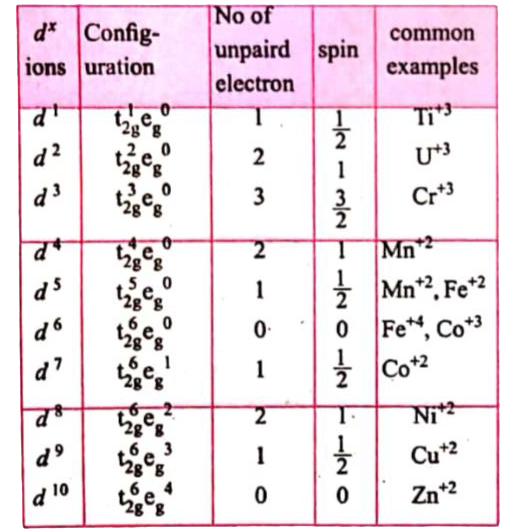Briefly explain how the electrons are distributed between t2g and eg sets in an octahedral complex in the presence of a stong field ligand.
Under the influence of strong ligands the enengy difference between t2g and eg set is relatively high and thus the distribution of .d. electrons in t2g and eg sets does not obey Hund.s rule. The first electrons number 1,2,3,4,5,6 will go to t2g set remaining four electrons numbered 7,8,9,10 will go to eg set.
t1,2,3,4,5,62g→e7,8,9,10g
For these complexes Δ0 is greater than p.

Topper's Solved these Questions
- CO-ORDINATION CHEMISTRY Book:PREMIERS PUBLISHERSChapter:CO-ORDINATION CHEMISTRY Exercise:Other Important Question & Answer (Choose the correct Answer)
Explore 30 Videos
- CHEMISTRY IN EVERYDAY LIFEBook:PREMIERS PUBLISHERSChapter:CHEMISTRY IN EVERYDAY LIFEExercise:OTHER IMPORTANT QUESTIONS& ANSWERS (ANSWER THE FOLLOWING QUESTIONS)
Explore 63 Videos
- ELECTRO CHEMISTRYBook:PREMIERS PUBLISHERSChapter:ELECTRO CHEMISTRYExercise:OTHER IMPORTANT QUESTIONS & ANSWERS (II. Answer the following questions: )
Explore 58 Videos
Similar Questions
Knowledge Check
t2g orbitals in octahedral complexes are
Adxy,dyz,dxzBdxy,dx2−y2,dz2Cdx2−y2,dz2Ddxy,dx2−y2In complexes off wea field ligands, Δo<P (pairing energy), the energy difference between t2gandeg sets is relatively less. Under the unfluence of strong field ligands, ΔO>p (Pairing energy), the energy difference between t2gandeg sets is relatively high.
Q. Which of the following is correct statement?AComplex [Co(H2O)6]2+ is more stable than [Co(H2O)6]3+BAll compounds of Ni(II) are bound to be outer-d-orbital complexesCStability constant for [Ni(en)3]2+ is greater than stability constant for [Ni(NH3)6]2+DΔoct for [Cr(H2O)6]3+ is greater than Δoct for [Cr(NH3)6]3+In complexes off wea field ligands, Δo<P (pairing energy), the energy difference between t2gandeg sets is relatively less. Under the unfluence of strong field ligands, ΔO>p (Pairing energy), the energy difference between t2gandeg sets is relatively high.
Q. Which of the following is correct statement?AComplex [Co(H2O)6]2+ is more stable than [Co(H2O)6]3+BAll compounds of Ni(II) are bound to be outer-d-orbital complexesCStability constant for [Ni(en)3]2+ is greater than stability constant for [Ni(NH3)6]2+DΔoct for [Cr(H2O)6]3+ is greater than Δoct for [Cr(NH3)6]3+
In complexes off wea field ligands, Δo<P (pairing energy), the energy difference between t2gandeg sets is relatively less. Under the unfluence of strong field ligands, ΔO>p (Pairing energy), the energy difference between t2gandeg sets is relatively high.
Q. Which of the following is correct statement?
View SolutionIn complexes off wea field ligands, Δo<P (pairing energy), the energy difference between t2gandeg sets is relatively less. Under the unfluence of strong field ligands, ΔO>p (Pairing energy), the energy difference between t2gandeg sets is relatively high.
Q. Select the correct statement regarding [Cr(en)2Cl2]+and[Co(C2O4)2(NH3)2]− complex ions:
View SolutionIn complexes off wea field ligands, Δo<P (pairing energy), the energy difference between t2gandeg sets is relatively less. Under the unfluence of strong field ligands, ΔO>p (Pairing energy), the energy difference between t2gandeg sets is relatively high.
Q. Select the correct statement regarding [Cr(en)2Cl2]+and[Co(C2O4)2(NH3)2]− complex ions:
View SolutionIn complexes off wea field ligands, Δo<P (pairing energy), the energy difference between t2gandeg sets is relatively less. Under the unfluence of strong field ligands, ΔO>p (Pairing energy), the energy difference between t2gandeg sets is relatively high.
Q. Select the correct statement regarding [Cr(en)2Cl2]+and[Co(C2O4)2(NH3)2]− complex ions:
View SolutionIn complexes off wea field ligands, Δo<P (pairing energy), the energy difference between t2gandeg sets is relatively less. Under the unfluence of strong field ligands, ΔO>p (Pairing energy), the energy difference between t2gandeg sets is relatively high.
Q. Select the correct increasing order of 10 Dq. value of chromium complexes:
(1) [Cr(en)3]3+
(2) [Cr(ox)3]3− ltBrgt (3) [CrF6]3−
(4) [Cr(H2O)6]3+
View Solution

